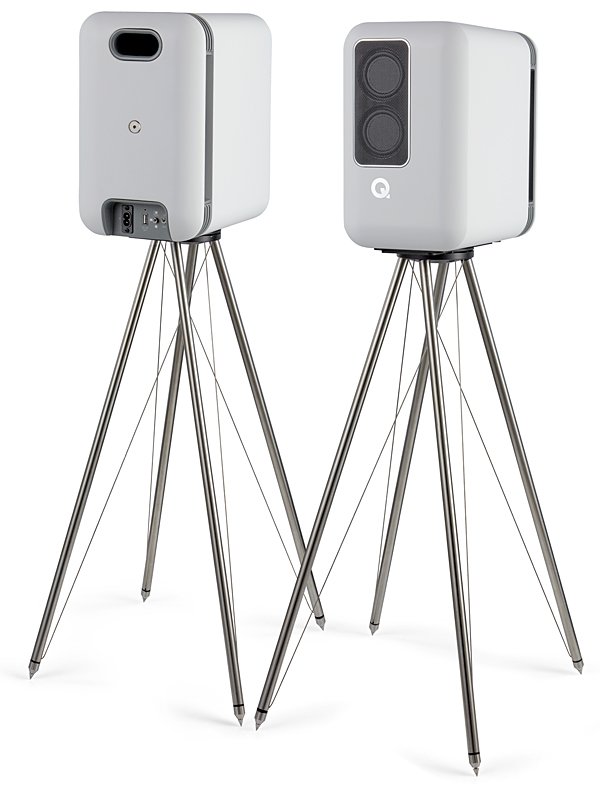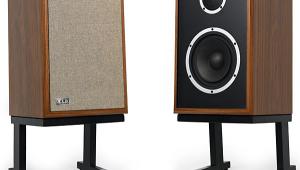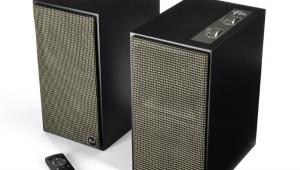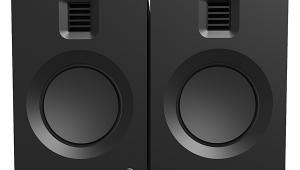Q Acoustics Q Active 200 Loudspeaker Review

AT A GLANCE
Plus
Accurate response and tonal balance
Spacious imaging with impressive off-axis performance
Unique looks and fine finish
Minus
Peak level may fall short for very large rooms
Ergonomics of physical controls and indicators
THE VERDICT
The Q Active 200 is a lifestyle-friendly system with serious chops, delivering impressive accuracy and range from a compact wireless design.
If there were any doubts that we are well into the Age of Stream, the recent proliferation of "just add music" audio systems should lay them to rest. Whether toaster-sized Bluetooth portables or full floor-standing systems, wireless all-in-one speakers conceived around high-quality streaming are definitely a thing, and one of the latest examples comes from Q Acoustics.
The British maker's new Q Active 200 is interesting on several fronts. First, it receives 24-bit/96kHz resolution music wirelessly via a 5GHz link from its supplied paperback- sized hub. Second, the Q A200 looks like no other speaker I've seen, and that's cool. Third, its electro-acoustic design is unusual, highlighted by a pair of Balanced Mode Radiator (BMR) drivers in each speaker, supported by a rear-firing woofer of conventional cone form.

BMR technology evolved from the late NXT (another Brit outfit) family of distributed-mode flat-panel drivers and has been getting a good bit of attention in the speaker- design world lately. Briefly, a BMR driver is a round (usually), more-or-less flat transducer that, while driven by a conventional voice-coil motor, emphatically does not maintain the pistonic, linearly in-out motion of conventional cones and domes. Instead, as the reproduced frequency increases, its surface "breaks up" into multiple vibrational modes, something like a flat-panel driver of the ribbon, electrostatic, or planar-magnetic type used in speakers.
BMRs are full-range drivers that reproduce higher frequencies almost as effectively as lower ones within the context of their overall diameter (the dual 2.25-inch BMRs in the Q Active 200 operate from 150Hz on up). And a BMR is an almost hemispherical radiator at all frequencies: unlike pistonic cone or dome midrange drivers and tweeters, a BMR driver does not tend to "beam" increasingly as the reproduced frequency ascends, but instead spreads its sound evenly into the forward half-space. This means that listeners will receive a notably spatial stereo effect from almost any position in front of a speaker pair, even one substantially off-center. Also, any colorations induced by room reflections should be lessened, since the reflected sound's spectral content is nearly identical to that of the direct sound.

The Q Active 200's driver complement highlights the dual BMR units, which are vertically arrayed off center on the front baffle. This arrangement promotes two potential setup options: "innie" and "outie," while the single 4.5-inch woofer fires aft, radiating from a false rear panel spaced an inch or so off the driver with a single ovoid port venting the enclosure. Each driver is individually driven by its own onboard amplifier. Q Acoustics' states only "100 watts continuous" and "280 watts peak" power, with neither figure evenly divisible by three, so I presume these are distributed to the BMR/woofer units along the lines of something like 20/20/60 watts. The 150Hz crossover between the BMRs and the woofer is about 10 times lower than most conventional two-way speakers, which means that a large-diameter woofer diaphragm is not forced to reproduce— and, willy-nilly, narrowly beam—midrange content. The crossover, and the boundary EQ options I'll discuss below, are presumably implemented in the digital domain, as all audio signals, whether digital or analog, are internally converted to 24bit/96kHz PCM.
It's an unusual package to be sure, one with a somewhat unusual look I found very appealing. The speakers are available in black or white and sport a very nice fit 'n' finish. I preferred the white of my review sample, which highlights the asymmetric front baffle look, but then I'm a sucker of long standing for white speakers.
Setup
Okay, let's put away the pocket-protectors and set up the Q Active 200s. The two speakers are identically featured, with a small rear panel proffering a two-prong IEC power connector, a USB type-B port marked "Update Only," and two mini-toggle switches. One of these sets the speaker's left/right status, while the other is used to select boundary-compensation EQ settings for corner, wall, or out-in-the- room placement. On top of each speaker are volume up/ down, and input-select touch "buttons" (bumps, really) plus a set of LEDs to identify the active input and power status.

Q Acoustics' hub can support sources streamed using AirPlay 2, Chromecast built-in, and Spotify Connect, and it also handles UPnP streaming over Wi-Fi or wired Ethernet. Additionally, there are optical digital, HDMI ARC, and analog stereo RCA (selectable between line- and phono-level) inputs for hardwired sources, a USB type-C port (power only), and a subwoofer output. Two separate hub options are avail- able: one with Chromecast built- in that supports Google's voice assistant, and a "Works with Alexa" version (coming in 2022). In this situation, you'll need to choose your voice control ecosystem carefully, since Q Acoustics doesn't sell individual hubs separately (should you switch alliances).

The hub's front edge has bump-buttons similar to the speakers, each with an adjacent LED that indicates status conditions through a hope- less confusion of steady fast or slow flashings and colors. Keep the online-only manual handy! Due to the blinding brightness level of the LEDs, it is completely impossible to read the labeling without substantial light directed on the hub's front panel (the same applies to the speakers' top-panel controls). I kept a powerful LED flashlight atop the hub for this specific purpose.
Setting up the speakers involved placing them atop stands (Q Acoustics provided a pair of its clever, stunning, but expensive Q FS75 stands, which I will return to later) plugging each into power, and setting the left/right and boundary switches appropriately—I started out with "innie" setup (BMR windows offset to the insides) and boundary EQ at "wall." For the hub, I connected the supplied USB power cable and supplied phone-style power adapter. At different times I connected the hub to my network both via wired Ethernet, and wirelessly—the latter requires only a bit more setup— observing no difference in performance.





























































